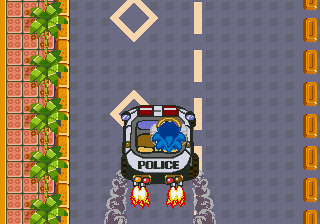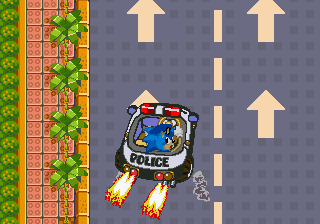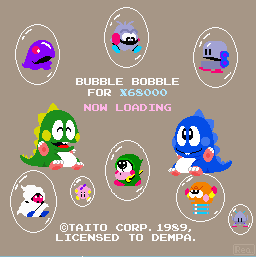MAME 0.166 was released today (the last Wednesday of September) and as always there are a few things I think are worth highlighting.
I was actually too busy to do any kind of update for 0.165, and this one is also going to be rather brief, but here goes.
Personally I’m always happy to see old / rare software for home systems dumped and emulated, and MAME documents via the Software Lists when this happens. Shortly before 0.166 two pieces of software for the Tomy Pyuuta were dumped and added to said lists, these are Triple Command and 3D Rescue, both of which are rare and expensive titles for the system, previously undumped
Triple Command is a simple time-pilot like shooter where you move around blasting waves of enemies. I’ve recorded a video a video of Triple Command and uploaded it
Rescue 3D is a more complex piece of software, or at least the controls are, I haven’t actually managed to figure it out properly yet, so to avoid complete embarrassment here are some screenshots instead of a video for that one.




In terms of functionality a potentially useful option ‘-global_inputs’ was added to MAME (built on top of the rawinput functonality) which allows MAME to still read inputs even when the MAME window isn’t in focus. The use of this might not be immediately apparent, but anybody who has tried using multiple connected instances of MAME on the same machine (for example to try out the comms work done by SailorSat) will have found the default logic problematic, as only the instance of MAME in focus could receive inputs.
Ramiro Polla was busy pushing more boundaries in the emulator with emulation of a printer, including emulating the motors, print head position etc. and rendering what would go to the paper on a virtual screen (we eventually need to decide on an actual output format for virtual printers) he uploaded his own video of this (with the printer running a self-test) which can be seen below. Remember, if something can be emulated we’re interested in emulating it, and even when things can’t be emulated fully we’re still interested in giving them a shot, at least to have the code running.
2 of the clones added in 0.166 are quite interesting too, the ‘Minefield’ and ‘Rescue’ sets were both created by ‘Free Enterprise Games’ which was apparently one guy in the UK. They’re interesting because they employ their own weird scrambling / protection techniques which have required extensive reworking of the code. Minefield I was able to fully descramble and get working, Rescue has caused more issues, it feels like there’s something missing (I’ve since compared it with the original and found out what the missing code should do, and can’t find it in ROM) Interestingly the game does have a single ROM with nothing but a message taunting anybody wanting to copy it, ironic considering AFAIK these weren’t actually licensed conversions anyway (I could be wrong, but nothing I’ve read leads me to believe they were)
The taunt message reads
” OR TAKE THE CONSEQUENCES AS IT IS A WASTE OF TIME TO TRY AND SUE YOU I WILL JUST SEND THE LADS AROUND ALL RIGHTS RESERVED COPYRIGHT 1983 BY JOHN RICHARDS OF FREE ENTERPRISE GAMES LTD IF YOU CAN GET THIS PROGRAM RUNNING AS A PROM CHANGE I WILL GIVE YOU A REWARD AND PROBABLY EMPLOY YOU AS WELL TELEPHONE 01 399 8587 GOOD LUCK ”
what is weird that it seems to start in the middle of the message, as if the ROM is too small, and the rom contains no useful code / data at all. We’ve encountered other games from ‘Free Enterprise Games’ before (a version of Anteater, which was then further ‘sublicensed’ to Tuning for Germany) but in those cases, like Minefield, locating all the code was easy enough, maybe I’m missing something obvious or the set is actually incomplete.
The ‘suicide-repair’ sets for a number of Sega 16-bit era games were also added in this release (as bootlegs, because they’re unofficial modified code, not approved by Sega) These are becoming commonplace on PCBs and the whole lot actually ended up being sold as a ‘Universal Sega Repair kit’ by an Asian seller, I’m not 100% sure they were all tested on hardware mind you, just looks to be somebody trying to cash in on their availability by pulling chips from other boards, erasing them and burning the sets to them! It’s hardly a universal kit as my contact who bought it was hoping! If you do find a specific set doesn’t work on hardware, let me know. It’s important for MAME to keep track of these things so if 20 years down the line boards get dumped that have been converted to run this unofficial code MAME recognizes it correctly so we don’t think it’s some long lost official set.
Under the hood there were some potentially important edge-case fixes for the M68020 CPU, not known to actually affect anything in MAME, but important, and entirely possible that some software for one of the home systems depends upon that we haven’t yet noticed.
Tweaks to the default state of the SN76489 sound emulation, improvements to the Sega PICO sound etc. also happened. XorWorld ended up with better sound and gameplay speed too.
There were some Chihiro improvements / fixes with a view to allowing the Xbox to boot, they do seem to have stopped OutRun2 from booting tho, so I can’t easily see if they improve anything there.
Some drivers were converted to use the generic ‘polynew’ rendering, including the Hyper NeoGeo 64 driver, this reduces code in the driver, and also potentially gives performance boosts as that code natively supports threading while the in-driver code did not.
The ‘Pacman on World Cup 90’ hardware bootleg is another weird one, we know who created it, Mike Coates, somebody who has contributed to MAME for many years in the past, however, it somehow ended up in use on some actual PCBs in Spain that were pulled from a bar. (Judging by the number of Pacman bootlegs originating in Spain it seems like there was almost an unwritten rule that every single place must have a Pacman machine?!)
(more to come)






































